It is expected that by 2025, decentralized stablecoins represented by Ethena will continue to grow in market size, reaching a 10% market share.
Author: Ray, ArkStream Capital
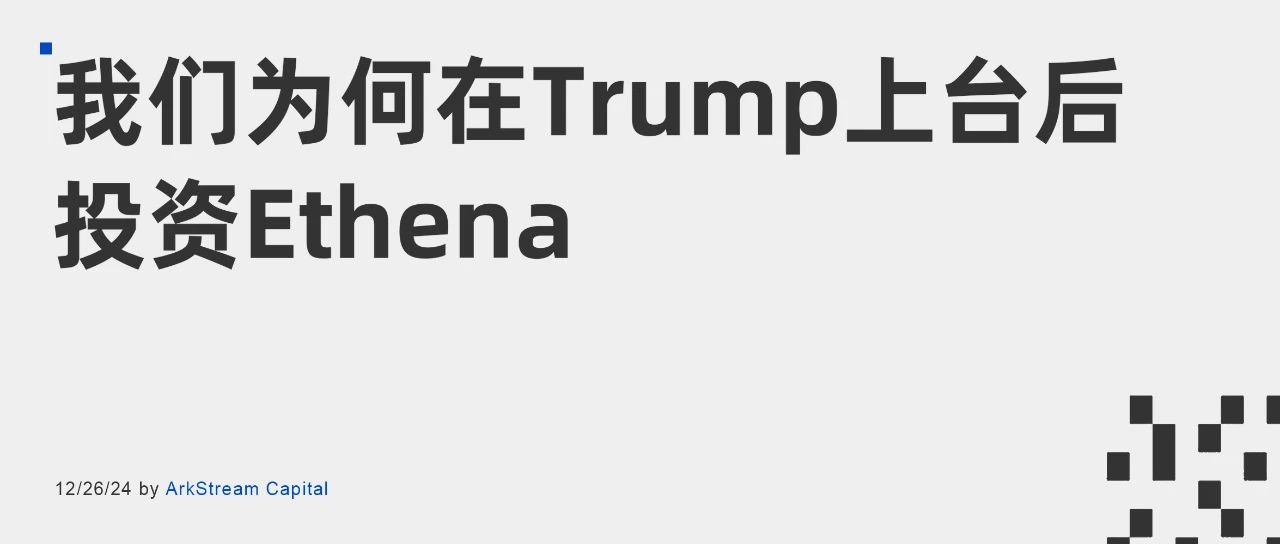
Prologue to a New Era of Strategic Investment: Ethena
On November 5, 2024, Trump successfully won the U.S. election, marking the beginning of an economic transformation in the U.S. led by traditional industries and decentralized finance. The core of Trump's policy is to break the dollar's hegemony over the U.S. economy, revitalize the industrial economy, and weaken the excessive control of the Democratic Party and its financial capital over the U.S. economy. In early November, ArkStream Capital keenly recognized the crucial role Ethena (ENA) would play at this historical moment and strategically invested $5 million in Ethena. As one of ArkStream's heavily invested projects, Ethena's performance has met our expectations, bringing us exceptional financial returns.
Ethena, as an innovator in the DeFi space, is committed to providing a variety of stable and scalable crypto-native currency solutions. Its first stablecoin, the crypto-native synthetic dollar USDe, features a core innovation that maintains intrinsic stable value by holding various mainstream crypto assets in spot and corresponding short positions through Delta hedging strategies. This design does not rely on traditional dollar bank reserves, allowing it to bypass the traditional financial system dominated by the Democratic Party, becoming a new alternative tool to the dollar.
The second stablecoin, USDtb, was developed in collaboration with the well-known RWA institution Securitize, leveraging BlackRock BUIDL to connect traditional financial products such as the dollar, short-term U.S. Treasury bonds, and repurchase agreements, creating a digital dollar supported by stable returns from real-world assets. This can efficiently channel funds into the U.S. industrial and real economy, aiding Trump's core goal of revitalizing industry and creating jobs.
It is worth mentioning that World Liberty Financial, led by the Trump family, although WLFI does not adopt a DAO model, demonstrates its grand vision in the DeFi space through its determination to push DeFi into the mainstream U.S. financial market. In the DeFi sector, among numerous sub-markets and infrastructure projects, those capable of generating sustainable income are particularly noteworthy, such as the lending platform AAVE, the oracle network LINK, the RWA-backed ONDO, and the ENA that promotes crypto-native stablecoin solutions. It is reported that WLFI has cumulatively invested $750,000 in Ethena tokens through on-chain transactions and announced a partnership to use Ethena's yield-bearing token sUSDe as collateral on the WLFI lending platform.
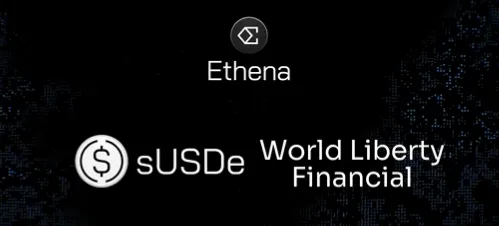
Source: https://x.com/ethena_labs/status/1869413546225983536
Investment Perspective on RWA Stablecoins
RWA (Real World Assets), payments, and stablecoins constitute three interwoven core elements in the financial sector. They can be considered as a whole in specific financial scenarios or viewed as specialized tracks with independent meanings. Among these three, the concept of payments is relatively clear, with application scenarios similar to those in the traditional financial world. The other two, RWA refers to assets that have been digitized through Web3 technology and transformed into transparent and easily tradable assets on the blockchain. This process covers a diverse range of asset classes, including stablecoins, private credit, U.S. Treasury bonds, commodities, and stocks. Given that stablecoins occupy a unique and significant proportion within this, they can also be considered as an independent track. This chapter will explore the growth rate and market space of RWA and stablecoins from an investment perspective, focusing on the evolution of the stablecoin market landscape and the development trajectory and challenges faced by crypto-native stablecoins.
Outstanding Growth and Broad Prospects
By combining the total asset value trend charts of RWA and stablecoins, we can intuitively grasp their market size and growth dynamics. Currently, the total asset value of the RWA market is approximately $218.3 billion, with the stablecoin market size reaching $203.4 billion, accounting for a staggering 93.2%. The stablecoin market has grown from $30 million at the beginning of 2018 to $203.4 billion now, such tremendous growth not only reflects the strong development momentum of stablecoins but also highlights their enormous market potential. In the non-stablecoin RWA sector, total asset value has increased from $10 million in 2018 to $200 million in 2021, and then skyrocketed to the current $14.9 billion, with a remarkable compound annual growth rate corresponding to this growth trend. In this growth process, private credit and U.S. Treasury bonds have played a key role.

Total Market Value of RWA (including stablecoins)
Source: https://app.rwa.xyz/
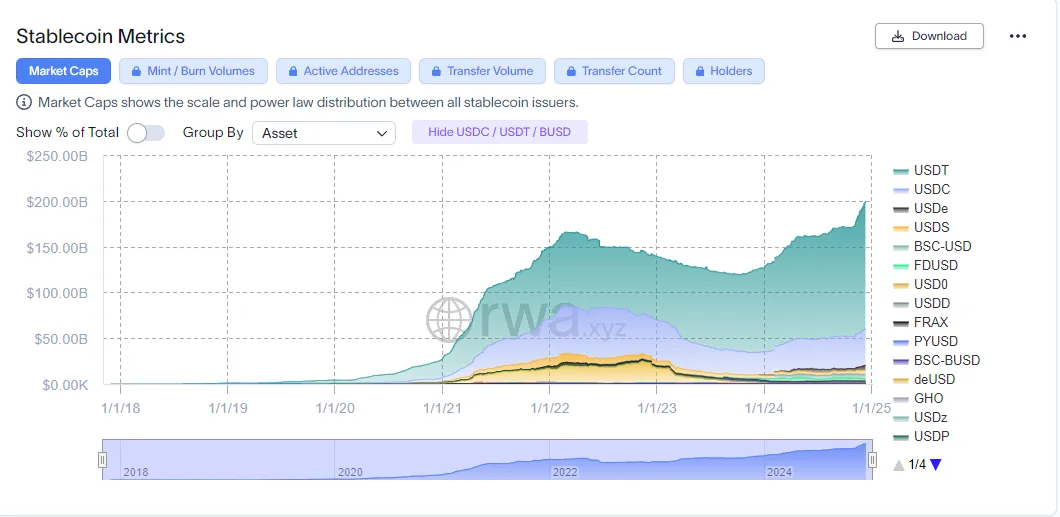
Market Value of Stablecoins
Source: https://app.rwa.xyz/stablecoins
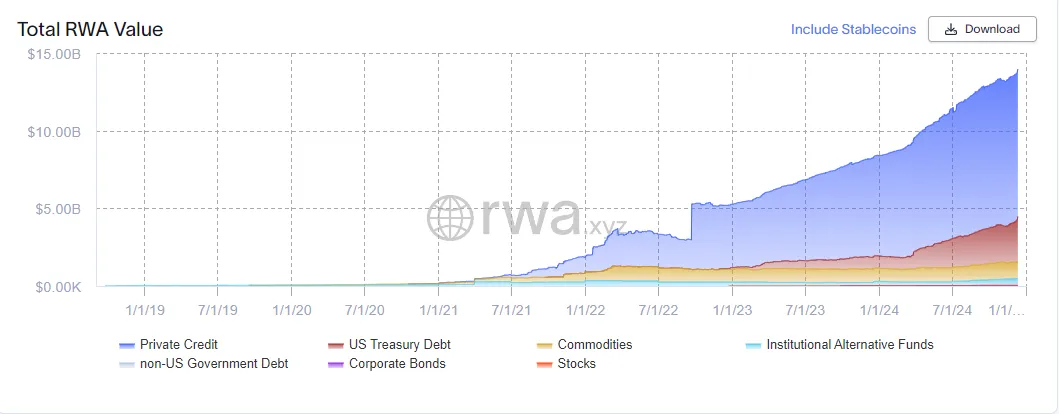
Total Market Value of RWA (excluding stablecoins)
Source: https://app.rwa.xyz/
Stablecoins, as a unique and key asset class within the RWA sector, deserve special attention and analysis. Before delving into this, let us first briefly understand the dollar and its related assets. The dollar, with its outstanding international status, has become a key currency for cross-border transactions, financial settlements, and global investments worldwide. The dollar and its related assets, such as U.S. Treasury bonds, play a core role in the financial market, further solidifying the dollar's status as the global reserve currency and making it a symbol of global hard currency.
In the cryptocurrency market, since 2018, dollar-pegged stablecoins have played a crucial role. They not only serve as the benchmark currency unit for transactions but also act as shadow dollar assets, active in various scenarios such as transfer payments. For example, the current daily transfer volume remains stable in the high range of $25 billion to $30 billion, and even during market downturns, this figure has not fallen below $10 billion. In terms of trading volume, according to a report by CCData, the monthly trading volume of stablecoins on centralized exchanges reached $1.8 trillion in November 2024, exceeding half of the total market capitalization of the cryptocurrency industry. Combining industry data from CoinMarketCap, we can estimate the daily trading volume in November to be $200 billion, meaning the monthly trading volume reached $6 trillion, which indicates that stablecoins account for 30% of the trading volume in centralized exchanges. This ratio does not yet include on-chain stablecoin trading volume, meaning the actual proportion may be even higher. In addition to these two core indicators of trading volume and transfer volume, stablecoins also provide stable and sustainable returns by introducing underlying assets such as U.S. Treasury bonds, bringing positive externalities to the industry and further promoting the connection and integration of Web3 with reality.
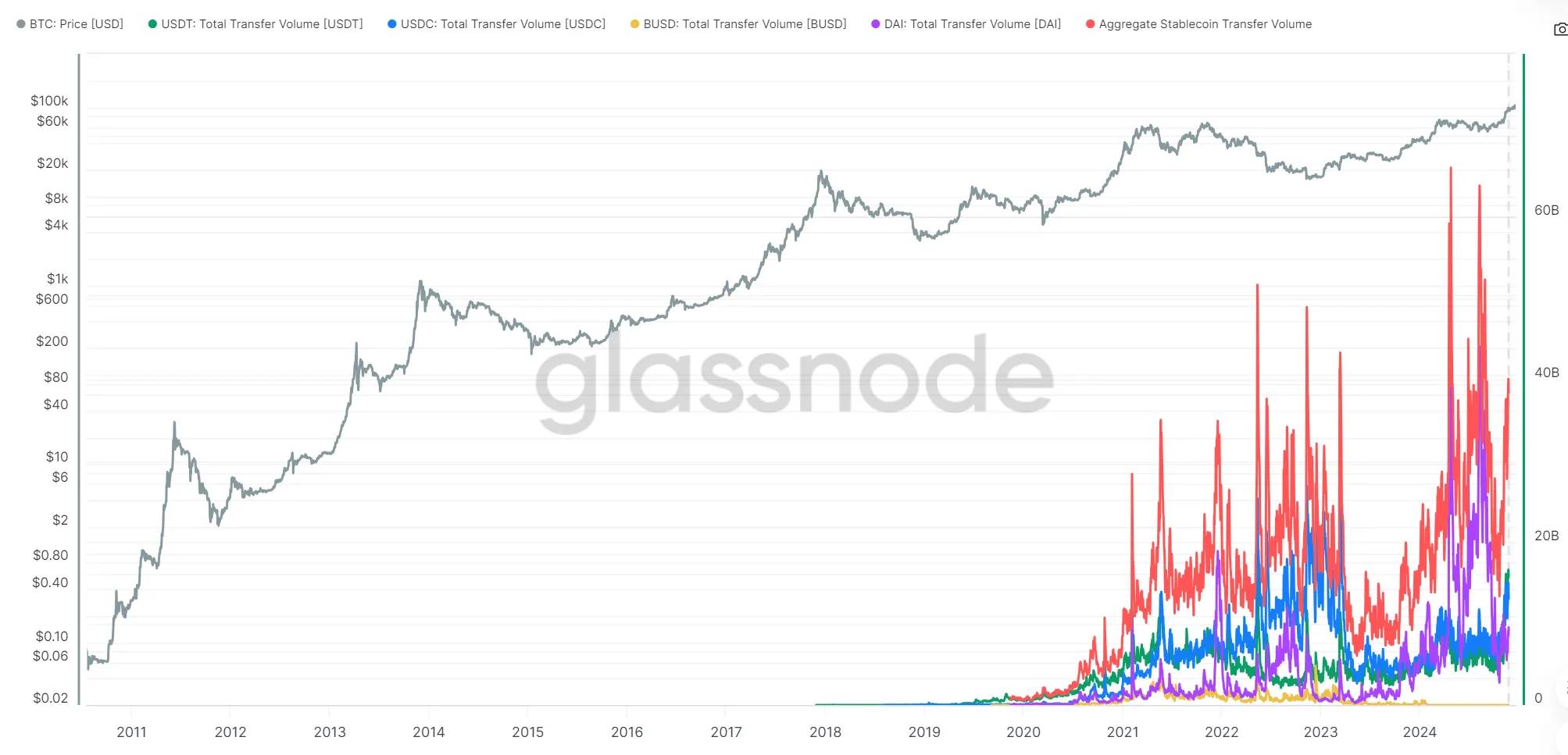
Daily Trading Volume of Stablecoins
Source: https://studio.glassnode.com/charts/usd-transfer-volume
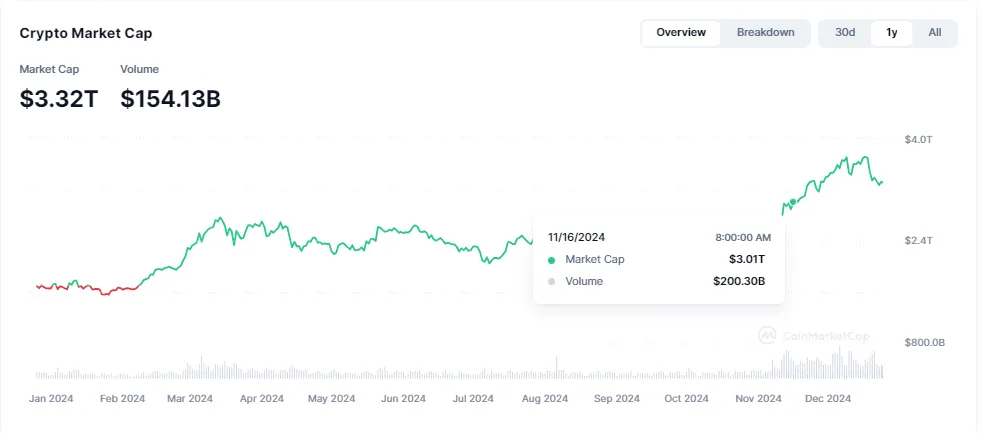
Market Value and Trading Volume of Stablecoins
Source: https://coinmarketcap.com/charts/

Tether's Profits for the First Three Quarters of 2024
Source: https://tether.io/news/tether-hits-7-7-billion-2024-nine-month-profits-102-5-billion-in-u-s-treasury-holdings-almost-120-billion-usd₮-circulation-and-an-over-6-billion-reserve-buffer-in-q3-2024-attestation/
With the approval of Bitcoin and Ethereum spot ETFs in 2024, the influx of funds has driven the total market capitalization of the cryptocurrency industry to a new high. We expect that with the growth of the industry’s market capitalization and the continuous expansion of the user base, stablecoins are also likely to break historical highs in several key data indicators such as market capitalization, transfer volume, and trading volume.
Evolution of the Stablecoin Market Landscape
The birth of stablecoins stems from the strong demand for price-stable tools in the cryptocurrency industry. In the early stages, mainstream cryptocurrencies like Bitcoin and Ethereum, due to their high price volatility, were difficult to serve as stable units of account. Stablecoins, by pegging to fiat currencies like the dollar, provided a relatively stable medium for value storage and transactions. This allowed users to hold a digital asset that could withstand market fluctuations and facilitate quick capital transfers. As the market's demand for stablecoins increased, various types of stablecoins gradually emerged, including fiat-backed stablecoins, decentralized collateralized stablecoins, and algorithmic stablecoins. These stablecoins offer users a diverse range of choices to meet different market needs and risk preferences.
In exploring the stablecoin market, we will focus on analyzing several representative stablecoins. These include USDT issued by Tether, USDC issued by Circle, DAI/USDS issued by the MakerDAO protocol, and the algorithmic stablecoin UST issued by Terra. Through a basic analysis of these stablecoins, we can understand the characteristics of each type of stablecoin and their market performance.
USDT, as an early stablecoin in the cryptocurrency market, has gained widespread market support and recognition since 2018. It is not only accepted by numerous exchanges but has also further penetrated both primary and secondary markets, DeFi protocols, various public chains, and Layer 2 solutions after 2020. As a result, USDT has maintained a leading market share. Currently, the underlying assets of USDT mainly include U.S. Treasury bonds and overnight reverse repos. Due to the lack of real-time updates on the transparency of these assets, USDT has historically experienced several de-pegging events, with the largest deviation approaching 10%. Nevertheless, USDT continues to dominate the spot and derivatives trading volumes on mainstream exchanges, leveraging its first-mover advantage and global applicability. Mainstream exchanges generally use USDT as the core trading currency pair, and even though they also support other stablecoins like USDC or FDUSD, USDT's trading volume and market depth still far exceed those of other stablecoins.

Tether's Q3 2024 Reserves Report
Source: https://tether.to/en/transparency/?tab=reports

Tether's Past Transparency Reports
Source: https://tether.to/en/transparency/?tab=reports
USDC, issued by Circle, which possesses strong regulatory resources and multiple asset management licenses, has become the second-largest stablecoin in the cryptocurrency market since its launch in October 2018, with a market share of approximately 20.9%. Based on its excellent compliance and transparency, the underlying assets of USDC mainly consist of cash in U.S. dollars, short-term Treasury bonds, and U.S. overnight reverse repos. Most USDC reserves are held in the Circle Reserve Fund (registered as a 2a- government money market fund with the SEC), which provides daily portfolio reports through BlackRock to ensure transparency. At one point, the issuance of USDC was close to 77.6% of USDT, but during the bankruptcy of Silicon Valley Bank (SVB) in March 2023, approximately $3.3 billion of Circle's USDC reserves were held at SVB, which was a small portion of its total reserves of $40 billion. This news triggered market panic, leading to a sharp drop in USDC's price and a de-pegging phenomenon, even triggering a bank run. However, with the joint rescue plan from the Federal Reserve and the Treasury, Circle announced that the deposits at SVB were 100% safe, gradually calming market panic and restoring USDC's price to near normal levels. After this incident, the vulnerability of USDC in the face of risks in the traditional banking system was fully exposed, leading to a downward trend in its issuance. To enhance the stability and transparency of USDC, Circle has implemented a series of measures. Although its market share has not returned to previous highs, USDC's inherent compliance keeps its on-chain trading volume and transaction numbers competitive with USDT.

Circle Reserve Fund
Source: https://www.blackrock.com/cash/en-us/products/329365/
DAI/USDS is a decentralized stablecoin issued and managed by MakerDAO, designed to maintain a fixed exchange rate of 1:1 with the U.S. dollar. Initially, DAI was generated through an over-collateralization mechanism, where users could lock crypto assets (such as Ethereum) in Maker's smart contracts to generate DAI. This mechanism requires the value of the collateral to be greater than the amount of DAI generated to ensure the stability of DAI's value. However, during periods of severe price volatility, DAI can lead to cascading liquidations, and the transparency of on-chain transactions makes the liquidation thresholds of minters easy targets for directed attacks, resulting in failed liquidations and bad debts. To mitigate these risks, MakerDAO has introduced more collateral options, such as USDC and wBTC, and established a dedicated risk management team. The decentralized nature of DAI provides unique advantages in certain application scenarios, particularly playing a core role in the DeFi space, not only as a medium of exchange but also widely used in lending, payments, and staking activities. Although DAI's market share is smaller compared to centralized stablecoins like USDT and USDC, its market capitalization still holds a place in the global stablecoin market.

Collateral List for DAI / USDS
Source: https://makerburn.com/#/rundown
UST, as a decentralized algorithmic stablecoin within the Terra ecosystem, aims to maintain a fixed exchange rate of 1:1 with the U.S. dollar. It relies on smart contracts on the Terra blockchain, using Luna tokens as value support. Users destroy an equivalent amount of Luna when minting UST and redeem an equivalent amount of Luna when destroying UST, with market arbitrageurs maintaining price stability. During periods of rising Luna prices, the mechanism of UST can promote a positive cycle, known as a "positive spiral." However, when Luna prices fall, the market capitalization of Luna struggles to support the market capitalization of UST, leading UST to easily fall into a "death spiral," where price declines cause UST to de-peg. UST once provided high yields through the Anchor Protocol, attracting user deposits and expanding its scale, becoming one of the major stablecoins in the market. Unfortunately, during the collapse of the Terra ecosystem in May 2022, UST's price stability mechanism faced severe challenges, ultimately leading to its decoupling from the dollar and its price dropping to zero. This event highlighted the risks and challenges of purely algorithmic stablecoins in terms of market confidence and algorithmic design, especially under extreme market conditions, where these challenges become particularly evident.
It is evident that in the stablecoin market, fiat-backed stablecoins have already captured a large portion of the market and are continuously growing in scale. However, due to the ever-emerging trading demands in the market, decentralized issued stablecoins have been exploring new paths. Among them, Ethena has emerged as a leader, with its USDe, a synthetic dollar, occupying a place in the DeFi space with its innovative financial solutions. The characteristic of USDe lies in its use of advanced Delta hedging strategies to maintain its peg to the dollar, making it stand out among traditional stablecoins. Additionally, USD0 issued by Usual is also noteworthy, as this stablecoin integrates RWA as its underlying support, deeply merging the robustness of traditional financial instruments with the transparency, efficiency, and composability of DeFi. USD0, with its permissionless and compliant framework, directly returns real yields from RWA to community users, showcasing the competitiveness of new stablecoins in the market. The emergence of these new stablecoins not only enriches market diversity but also provides users with more choices and investment opportunities.
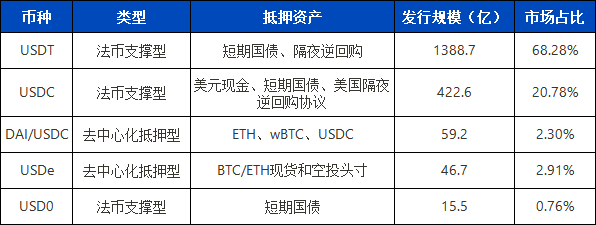
Core Indicators of Crypto-Native Stablecoins
We define stablecoins like USDe and USD0, which do not rely on fiat backing, as "crypto-native stablecoins." These stablecoins include those collateralized by mainstream cryptocurrencies like Bitcoin and Ethereum, algorithmically pegged stablecoins, and those using neutral strategies to anchor value.
When evaluating these crypto-native stablecoins, we will consider multiple dimensions, with the most important being the stablecoin's stability, market capitalization, and application scenarios (including DeFi integration and support from centralized exchanges).
Stability is a key indicator for measuring the value of stablecoins. The core value of a stablecoin lies in its value stability, meaning it can maintain a stable exchange rate with the pegged asset. If a stablecoin cannot maintain this pegging relationship, its "stability" will be called into question, thus losing its fundamental function as a stablecoin.
Under the premise of ensuring the stable pegging of the stablecoin's price, it must achieve a certain market scale to become a mainstream currency and occupy a place in the financial ecosystem. If a stablecoin cannot achieve scale expansion, its influence and practicality will be limited, making it difficult to have a significant impact in a competitive market.
The market scale of a stablecoin depends on its breadth of application scenarios. A stablecoin lacking practical application scenarios, regardless of its market capitalization, will struggle to solidify its market position, much like a tree without roots. Therefore, stablecoins must exhaust all means to gain a broader user base and diversified application scenarios to ensure the stability of their value and enhance their liquidity.
Why We Invest in Ethena
Ethena's vision is to reshape the cryptocurrency system by building bridges between DeFi, CeFi, and TradFi to promote the prosperity of the next generation of internet finance. Its first stablecoin, USDe, has achieved deep integration in several key areas of DeFi, including money markets, leveraged collateral in derivatives markets, stablecoin infrastructure, interest rate swap agreements, and spot AMM DEXs. In the exchange sector, Ethena's liquidity pools not only support existing centralized and decentralized trading platforms but also help emerging exchanges solve liquidity challenges during their initial launch, becoming a market leader in depth and over-the-counter liquidity provision. For TradFi, Ethena's USDe is favored for its unique yields, as this stablecoin integrates local real yields from two billion-dollar scale cryptocurrencies, and its yields are weakly negatively correlated with traditional financial interest rates, with underlying assets held by custodians recognized by TradFi. USDe provides large investors with a convenient way to achieve excess returns in the cryptocurrency market through a single asset. As real interest rates decline and market speculation and leverage demand for cryptocurrencies grow, it is expected to further boost the yields of Ethena's USDe, making it an important driver for attracting TradFi entities with trillions of dollars to invest in the Ethena ecosystem.

Delta-Neutral Synthetic Dollar USDe
The USDe stablecoin launched by Ethena, as a crypto-native asset, differs from dollar stablecoins that rely on traditional assets like U.S. Treasury bonds for backing. Its issuance mechanism involves holding mainstream cryptocurrencies in spot markets and establishing short positions on exchanges. This innovative model of stablecoin plays an important role in the market, not only locking in the value of mainstream crypto assets but also injecting liquidity into the derivatives market. Especially during bull markets, as the prices of mainstream assets rise and the scale of derivatives contracts expands, the scale of USDe also grows. Additionally, the short funding rate of USDe offers holders a more attractive yield compared to traditional stablecoins like USDT. This advantage attracts more users to choose USDe, further driving its scale expansion.
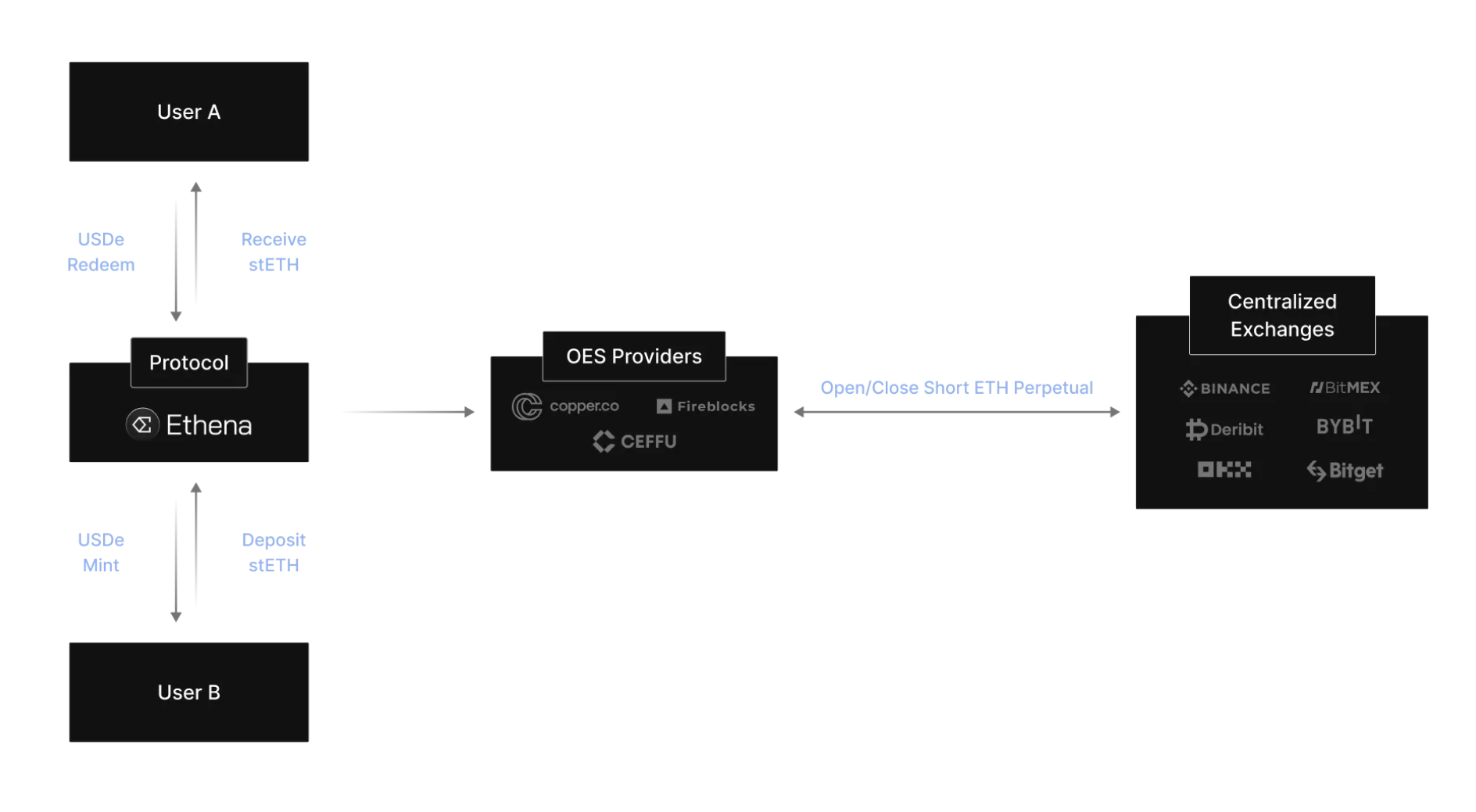
Minting, Redemption, and Staking
The minting process of USDe allows users to exchange USDe by sending underlying assets to the protocol, while redemption involves users destroying USDe to redeem the original supporting assets. Staking USDe enables users to lock USDe in a smart contract to earn yields. When users stake USDe, they receive sUSDe, whose value increases as the protocol accumulates yields. Users can unstake sUSDe at any time to obtain USDe with accumulated value.
Delta-Neutral Pegging Mechanism
The pegging mechanism of USDe primarily achieves stability relative to its underlying supporting assets through the execution of automated and programmatic Delta-neutral hedging strategies. This strategy establishes short positions equivalent to the spot assets in the derivatives market to offset the risk of price fluctuations in the spot assets, thereby maintaining the synthetic dollar value of USDe relatively stable under most market conditions. Additionally, the revenue sources of the Ethena protocol, including spot staking yields and short position funding rate income, further enhance the stability of USDe. Through this series of mechanisms, USDe can become a reliable medium of exchange and a store of value in the crypto market, maintaining a stable peg to the dollar.
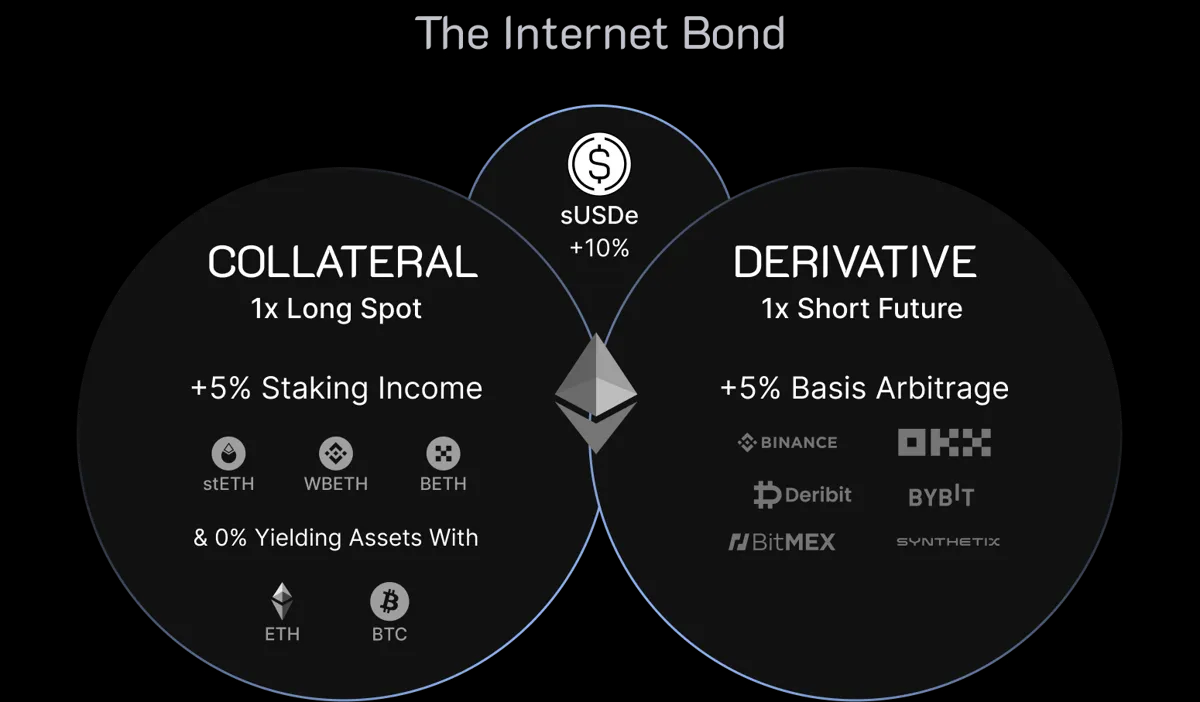
Hedging Strategies and Risk Control
Ethena's hedging mechanism is a system composed of off-chain application services that interact with on-chain smart contracts and the Ethereum blockchain. It is responsible for acquiring market data, verifying data integrity, calculating risk exposure, coordinating internal system information, publishing minting and redemption prices for USDe, determining order routing and execution locations, real-time verification of information and operational integrity, monitoring the availability of dependencies, coordinating collateral flows, and publishing real-time developments. This system focuses on protecting the protocol's collateral, ensuring the stability of USDe and the real-time integrity of the system. Furthermore, Ethena has a profound understanding of various potential risks, including smart contract risks, external platform risks, liquidity risks, custodial operation risks, exchange counterparty risks, and market risks. To address these challenges, Ethena actively takes measures to mitigate and diversify these risks, enhancing the robustness and reliability of the entire system.

Transparency and Fund Security
The core value of a stablecoin lies in its pegging ability, which is to maintain the stability of the value of the fiat currency it is linked to. Historically, some stablecoins like USDT and USDC have experienced de-pegging phenomena due to insufficient transparency and inadequate risk control mechanisms. To address this, Ethena ensures the stability and transparency of its asset management by adopting multi-signature and asset custody mechanisms, as well as establishing deep cooperation with exchanges. Additionally, in response to rate fluctuations during extreme market conditions, Ethena has established sufficient reserve funds. This series of strategies not only enhances the credibility of USDe but also provides a solid security guarantee for its yields, ensuring the interests of holders and the stability of the market.

TradFi-Friendly Digital Dollar USDtb
USDtb is an institutional-grade stablecoin backed by BlackRock, the world's largest asset management company, with backing assets including high-quality short-term Treasury bonds, ensuring its exceptional safety and trustworthiness. In the DeFi space, USDtb is not only fully accessible and easy to integrate but can also be used as collateral in centralized exchanges and major brokers, providing traditional financial institutions with direct access to DeFi. Furthermore, USDtb features a unique on-chain direct minting and redemption mechanism, enabling 24/7 service, further enhancing its competitiveness and convenience in the digital asset market.
As a product independent of USDe, USDtb offers users a new choice with distinctly different risk characteristics. Its existence allows USDe to respond more effectively to market challenges, especially during periods of negative funding rates, where Ethena can close USDe's hedging positions and reallocate assets to USDtb, thereby mitigating related risks and enhancing the overall stability and risk resistance of the system.
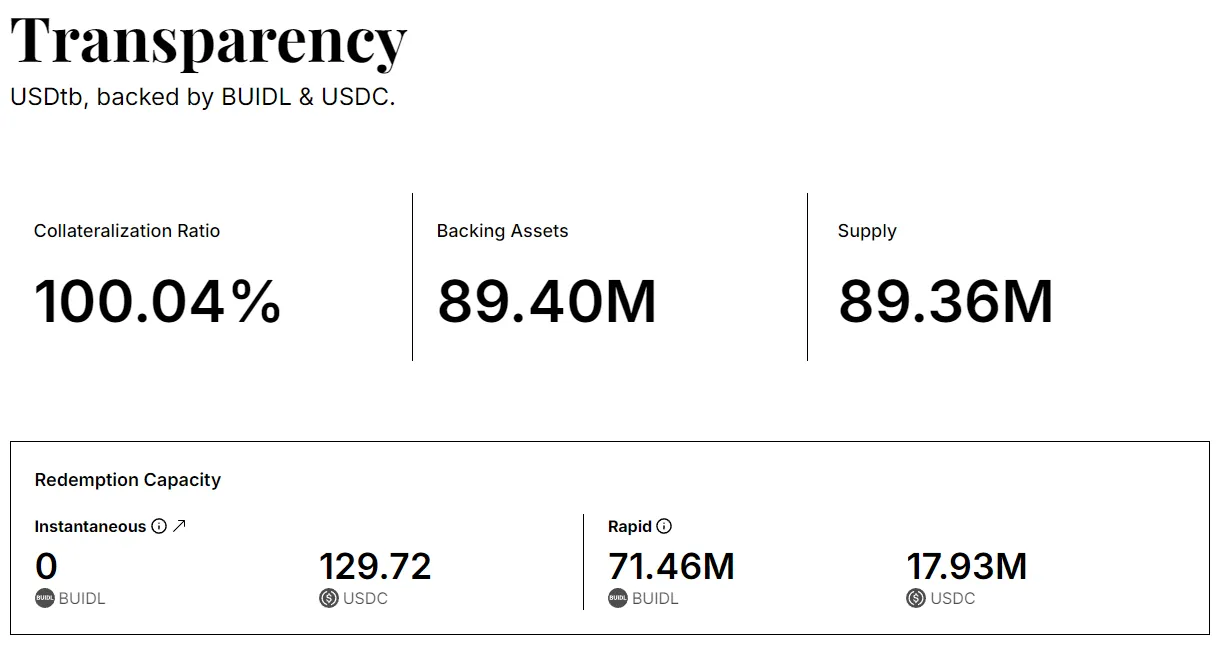
ENA Token Design
The ENA token plays a key role in the Ethena ecosystem, serving as a governance token that grants holders the right to participate in key decisions, such as electing risk committee members and shaping policy directions, while also providing opportunities to stake and become sENA for additional yields. As ENA will be used as a voting tool for the Ethereal derivatives exchange in the future, its importance in Ethena's development blueprint is increasingly highlighted. These functions not only solidify ENA's position as a core of the Ethena protocol but are also crucial for maintaining the protocol's decentralized governance and incentivizing user participation.
In terms of liquidity, ENA performs excellently on mainstream exchanges, consistently ranking high in trading volume, which not only demonstrates the market activity of the Ethena protocol but also indicates its broad recognition and acceptance in the market.

Operational Resources
Ethena has implemented a series of hedging strategies through deep cooperation with major exchanges to respond to emergencies in the derivatives market, ensuring the stability and security of USDe. Additionally, the use of USDe as a trading currency pair is gradually being realized, thanks to Ethena's efforts to increase liquidity to mitigate risks. In terms of resources, Ethena collaborates with several top global market makers, who provide liquidity and market depth, further enhancing the market adaptability and resilience of USDe.
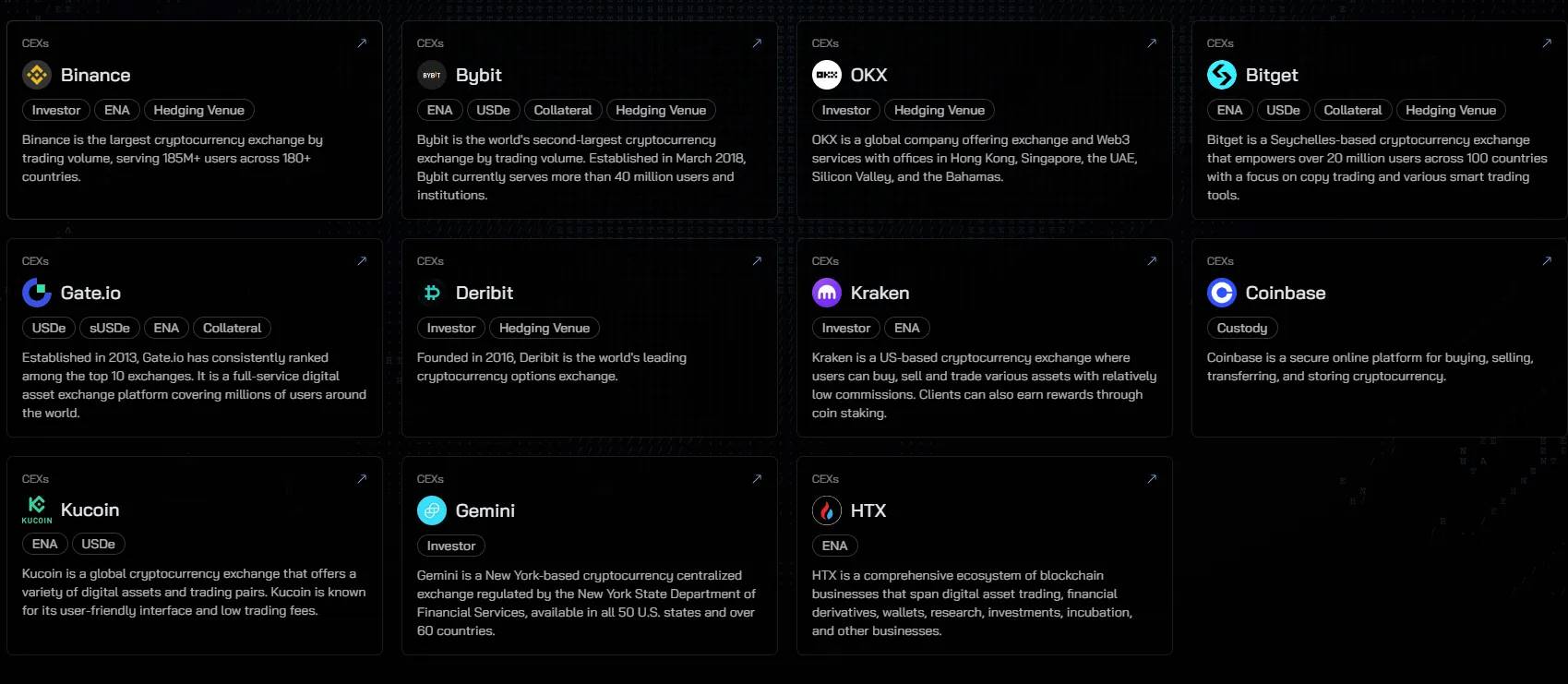
Source: https://ethena.fi/ecosystem

Future Prospects of Ethena
In the stablecoin sector, the competitive landscape is far from settled. While USDT and USDC hold leading positions, emerging competitors are fully capable of challenging their market status. The key lies in selecting stablecoin protocols that possess unique mechanisms, can stabilize pegged values, increase market capitalization, and expand application scenarios. Just as DEXs have captured 10% of CEX trading volume, decentralized financial products are rapidly seizing market resources due to their verifiability and convenience. We expect that by 2025, decentralized stablecoins represented by Ethena will continue to grow in market size, reaching a 10% market share, equivalent to $20 billion.
At the same time, we believe that Ethena will become one of the important financial tools for implementing Trump policies. The implementation of Trump policies will also promote Ethena's strategic position in the revival of the U.S. economy and the reshaping of global finance, becoming an important support for the domestic and global digital financial ecosystem. As an industry pioneer, ArkStream Capital will witness this great transformation in the era of decentralized finance alongside Ethena.
免责声明:本文章仅代表作者个人观点,不代表本平台的立场和观点。本文章仅供信息分享,不构成对任何人的任何投资建议。用户与作者之间的任何争议,与本平台无关。如网页中刊载的文章或图片涉及侵权,请提供相关的权利证明和身份证明发送邮件到support@aicoin.com,本平台相关工作人员将会进行核查。




